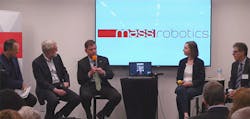U.S. Labor Secretary participates in expert panel on robots in the workforce
More robots joined the U.S. workforce last year than ever before, according to the International Federation of Robotics. On March 18, a panel at MassRobotics’ Boston facility discussed what this influx of technology means for workers; the economic benefit resulting from improved productivity through robotics; and how we can build better jobs alongside intelligent machines.
MassRobotics is an innovation hub and startup cluster focused on the needs of the robotics community.
In celebration of MassRobotics’ fifth anniversary, the collective hosted U.S. Secretary of Labor Marty Walsh and an expert panel including Elizabeth Reynolds, special assistant to the president for manufacturing and economic development at the National Economic Council; Tom Ryden, executive director at MassRobotics; Julie Shah, associate professor of aeronautics and astronautics at the Massachusetts Institute of Technology (MIT); and Ira Moskowitz, CEO of the Advanced Robotics for Manufacturing Institute. The panel was moderated by Scott Kirsner, contributing editor at The Boston Globe.
Also read: Technology boosts power of the human workforce
To open the discussion, Ryden explained that along with the tremendous growth in robotics in the past five years came a growth in the concern about robots and labor.
The panel discussion focused on the tension between people doing the jobs and those making the robotics to help them perform those jobs.
“The fear of a robot doing complete manufacturing without any human beings in there isn’t going to happen,” said Walsh. “We’re always going to have that, and I think that, if you think about this unique moment in time, the pandemic was not good for a lot of reasons, but in some cases the pandemic helped us reshape and rethink what the future of work looks like.”
Moskowitz added he’d never personally seen anybody deploy robotics to replace a person, not before the pandemic, and not even before the labor shortages. “It’s all about having jobs that are difficult for a human to do or dangerous for a human to do or can’t be done with the right rework or the right cycle time, and replace that, but the person is still there,” he said.
While robots have proliferated in manufacturing facilities, many are collaborative or assist workers, Shah noted. In fact, many robotics that are currently implemented in factories are designed to assist and improve the wellbeing of workers, rather than replace the worker, she said.
“What we see happening in factories is how you can carefully design these human-machine partnerships to add value, productivity and efficiency but also improve the economic opportunity and the wellbeing of workers,” said Shah. “The key thing is these technologies don’t take jobs. They do tasks. Then we have the task of figuring out how we task them and how we organize how we work and how we work with one another to put the technology in just the key level points to achieve what we want to achieve. And there’s enormous opportunity that I often worry is obscured by the concern that these technologies will just automatically take jobs.”
Shah also shared her experience doing site visits and interviews with small- to medium-sized firms in Europe and the United States, asking leaders about the business case for investing in innovative technologies and the value they provide. While some leaders were driven by the goal of a lights-out factory, many were not, she noted, highlighting one leader who said that a factory without people is a factory that’s not innovating.
“When you program a robot, it’s ossified,” explained Shah. “That is what the robot will do, but, in every setting and factory across many other areas of our work, there’s a progressive learning curve, and that’s human-driven. There are technologies that we make that better enable bringing those domain-expertise workers to the table to be able to help design these robots and deploy them to do tasks in a way that leverages the capabilities that we have as people to do more than just what machines can do by programming them.”
Ryden agreed that robots aren’t going to replace workers. “Robots are going to augment workers,” he advised. “Most of the companies that we have here are doing some form of what we call collaborative robots or robots that work side-by-side with people. And the idea is you take the best out of people, you take the best out of robotics, you put them together, and that’s going to be the win. What we have to do though, to Liz’s point, is get the workforce trained on this technology, so they can use it and adopt it and feel comfortable when they get to a workforce.”
The panel agreed that a concerted effort from governments and businesses needs to be made in order to show that robotics enhance jobs, rather than take them. They also agreed that more emphasis should be put on education because there is a desperate need for trained workers in advanced manufacturing.
In the past, we’ve been siloed, explained Walsh. “Business over here, labor of here, companies over here—we need to be collectively together to push that forward,” he said. “Businesses could invest in community colleges, as well as push governors and states, because you’re creating jobs.”
While Walsh is leading the charge on the future of labor, President Joe Biden has also expressed interest in the topic. Moskowitz outlined a visit with Biden in which they discussed these issues. “We talked about this narrative and how we’re all doing what we can to prove that this is not true,” Moskowitz said.
Reynolds outlined some of the Biden Administration’s efforts in this area, specifically those focused on building resilient supply chains and reshoring U.S. manufacturing and the important role that the workforce will play in this.
“He’s basically set the stage for a new industrial strategy for the country,” said Reynolds. “In the face of the pandemic, and now in terms of geopolitical issues, we’re seeing a need for resilient supply chains. We have a major executive order that came out just when he came into office that is focused on where we have weaknesses in our supply chains in critical areas, whether it’s PPE or semiconductors, critical minerals, advanced batteries, pharmaceutical APIs, areas in which the country is actually vulnerable. And domestic production is an important part of our strategy going forward.”
Noting the overall need for workers in advanced manufacturing, Moskowitz said there is potential for underserved and underrepresented communities in the advanced manufacturing workforce. “We need people in some of these underserved communities to enter the workforce; otherwise we will never close that gap in what’s required for advanced manufacturing,” he said.
In line with this is the issue of attracting students to training and workforce-development programs for advanced automation technologies.
The answer, again, is education. Ryden explained that he’s heard from community colleges about a lack of interest in existing advanced manufacturing programs. “How do we get students excited in some of these fields?” he asked. With the use of robotics and understanding that there is a pathway for jobs that were traditionally very manual, but now with technology, will be very different, we can interest a new generation, Ryden said.
This is again the result of the disconnect between industry, education and government, reiterated Walsh.
“Where’s the disconnect from, and how do we get you into the right workforce development program with the right employer to move forward?” Walsh asked. “That’s what we have to be very intentional about.”
He added that the community doesn’t always know what is available, and educating them that robotics are within their grasp and providing a pathway to a career would relieve many of these concerns.
“I think that you in this room know, the students in this room know, but I think that the greater society has no clue, and they think that robotics isn’t within their grasp,” he said. “We have to educate people and make sure it’s a real opportunity.”
About the Author
Amanda Del Buono
Digital Engagement Manager
Amanda Del Buono is the Digital Editor at Control. Prior to this role, Amanda was the Associate Editor at Beverage Industry magazine. Amanda earned a Bachelor degree in Journalism from The University of Missouri – Columbia, and currently lives in Illinois.

Leaders relevant to this article:

